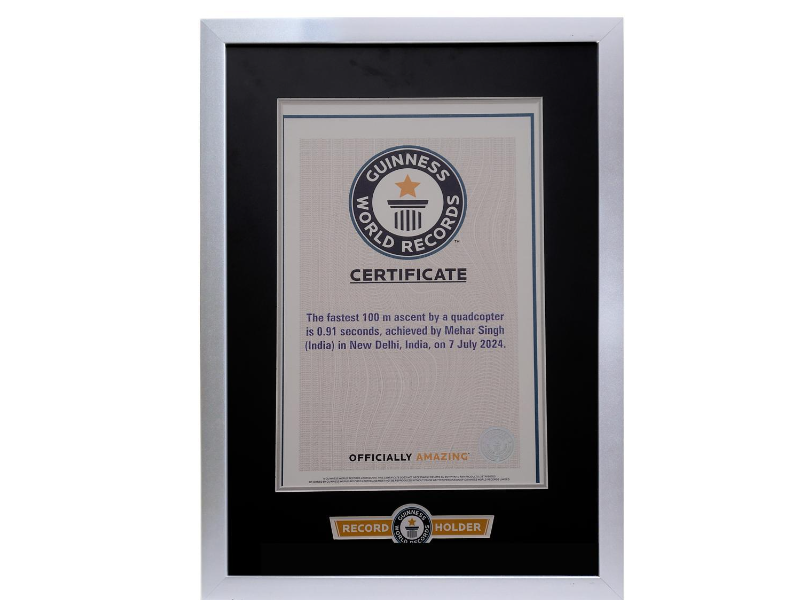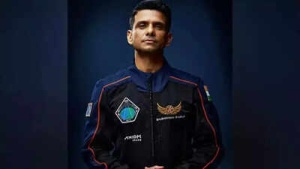Mehar Singh, a remarkable 17-year-old, has etched his name in the annals of drone technology by achieving a new Guinness World Record. He secured the title for the fastest 100-meter ascent by a quadcopter. Singh’s custom-built drone accomplished this feat in a breathtaking 0.91 seconds. This showcases his exceptional technical skill and establishes a new benchmark within the rapidly progressing field of unmanned aerial vehicles.

Singh's path to this achievement was fueled by his burgeoning interest in drones, which began in the 8th grade. Driven by a desire to push technological boundaries, he invested months in designing and constructing a drone capable of unprecedented vertical acceleration.
"I've always been captivated by the idea of expanding the possibilities of drone technology," Singh stated. "Achieving a world record was not solely about the outcome, but about the entire journey. My aim was to demonstrate that existing technology could reach extraordinary heights, even with the inherent challenges."
His endeavor necessitated the design, rigorous testing, and refinement of numerous drone prototypes. "There were times when I felt as though I was pursuing an unattainable goal," Singh remembered. "I experimented with countless designs, and many failed during testing. Some drones experienced catastrophic failures, forcing me to return to the drawing board. While each setback was discouraging, it also spurred new ideas and innovations."
Unfazed by these obstacles, Singh focused his energy on creating a drone that was not only exceptionally fast but also aerodynamically optimized. "I dedicated numerous hours to CAD software, meticulously designing and fine-tuning each component," he explained. "The objective was to create the most streamlined drone possible, which led to its rocket-like shape. This design choice was not merely aesthetic; it was about minimizing drag and maximizing velocity."
Singh's commitment to his craft resulted in a resounding success. "Each failure provided valuable lessons," he reflected. "It compelled me to think creatively and to meticulously consider every detail, from the materials used to the weight distribution of the drone. While the process was demanding, witnessing my ideas take flight was immensely rewarding."

This record-breaking accomplishment transcends personal achievement for Singh; it holds significant promise for the future of drone technology. "The possibilities are boundless," Singh speculated. "High-speed vertical acceleration could transform various sectors, from emergency response to space exploration. This is not simply about setting a record; it is about unlocking new innovations and applications."
Singh's pioneering work has inspired others within the drone community and beyond. "I hope this achievement encourages other young innovators to push their own limits," he stated. "Technology is advancing at an unprecedented rate, and there is immense potential waiting to be realized. I am eager to see what we can achieve in the future."

As Singh looks to the future, the possibilities are limitless. His record-breaking drone has not only made history but also established a foundation for future advancements in drone technology. For this young innovator, this marks the beginning of an exciting journey into the future of flight.
Newer articles
Older articles
 Android Security Alert: Government Warns of Critical Flaws Exposing User Data
Android Security Alert: Government Warns of Critical Flaws Exposing User Data
 5 Overlooked Warning Signs of Colon Cancer: Early Detection Saves Lives
5 Overlooked Warning Signs of Colon Cancer: Early Detection Saves Lives
 Ashada Gupt Navratri 2025: Dates, Significance, and How to Observe This Hidden Festival
Ashada Gupt Navratri 2025: Dates, Significance, and How to Observe This Hidden Festival
 Shukla's ISS Arrival Heralds New Era for Indian Space Exploration; Gaganyaan Mission Looms
Shukla's ISS Arrival Heralds New Era for Indian Space Exploration; Gaganyaan Mission Looms
 Milne, Henry Earn New Zealand Recall for T20I Tri-Series; Uncapped Jacobs Included
Milne, Henry Earn New Zealand Recall for T20I Tri-Series; Uncapped Jacobs Included
 X (Formerly Twitter) Bans Half a Million Accounts in India Amid Policy Crackdown
X (Formerly Twitter) Bans Half a Million Accounts in India Amid Policy Crackdown
 xAI to Open Source Grok Chatbot: Musk Pushes for Accessible AI, Accuses OpenAI of Betrayal
xAI to Open Source Grok Chatbot: Musk Pushes for Accessible AI, Accuses OpenAI of Betrayal
 Indian Astronaut Shubhanshu Shukla to Connect with Students, ISRO Scientists from Space
Indian Astronaut Shubhanshu Shukla to Connect with Students, ISRO Scientists from Space
 20 Minutes to a Healthier You: Neurologist's Simple Steps to Reduce Cholesterol, Blood Pressure, and Dementia Risk
20 Minutes to a Healthier You: Neurologist's Simple Steps to Reduce Cholesterol, Blood Pressure, and Dementia Risk
 Google Maps to Sharpen Navigation with Fused Orientation Provider API Update
OR
Google Maps Enhances Directional Accuracy with Fused Orientation Provider API Upgrade
OR
Google Maps Update Targets Improved Navigation Accuracy via Enhanced API
Google Maps to Sharpen Navigation with Fused Orientation Provider API Update
OR
Google Maps Enhances Directional Accuracy with Fused Orientation Provider API Upgrade
OR
Google Maps Update Targets Improved Navigation Accuracy via Enhanced API